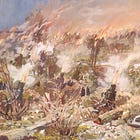More About Mortars
A sequel to 'Find the Hidden Mortars'
In the immense literature on the subject of war, warfare, and warfighting, mortars rarely get the attention that they deserve. Here at The Tactical Notebook, which has published more than thirty articles about the Joe Rogan of infantry ordnance, we have done much to remedy this sorry state of affairs. Still, the reader wishing to master the subject will quickly exhaust our offerings on the subject.
For this reason, The Tactical Notebook published a short guide to resources related to mortars that can be found beyond the borders of this blog. Inspired by a comment from a reader who finds himself in a recently revived mortar outfit, this post builds upon that work. In particular, while Find the Hidden Mortars provides lots of links to American resources, More About Mortars casts a somewhat wider net.
The Telegram channels of Ukrainian Territorial Defense units feature lots of photos and videos of soldiers training with various kinds of mortars. Taken together, these provide lots of opportunities to practice the art of distinguishing among the sights and sounds associated with particular pieces of equipment.
To find such channels, search on the phrase ‘territorial defense’ [територіальної оборони]. Once you have found a suitable channel, search on the word ‘mortar’ [міномет]. (Please note that, while міномет uses letters that resemble characters found in the Latin alphabet, typing ‘mihomet’ into the search box will not work. Rather, you will have to ‘cut and paste’ from text composed on a Ukrainian keyboard or generated by a translation program.)
Typing the word ‘mortar’ into the search engine of Axis History Forum yielded more than eight thousand ‘hits’. (While the Schwerpunkt of the forum reflects its name, many of the discussions deal with eras other than that of the Second World War and armies other than those led by fully paid-up members of the Benny the Moose fan club.)
I have yet to read either volume of Mortar Gunner on the Eastern Front, let alone both tomes of that two-part memoir. A quick recce of the work, however, suggests that the author, Hans Heinz Rehfeldt, paid a great deal of attention to the tactical context of his experience. Better yet, the fact that he served in the (very well documented) Großdeutschland organization will facilitate efforts to reconstruct some of the engagements in which he took part.
As befits a doctoral dissertation Die Entwicklung des Granatwerfers im Ersten Weltkrieg [The Development of Mortars in the First World War] provides an enormous amount high-angle goodness, to include a collection of technical appendices that will warm every hoplophile heart and the mother of all bombardischtisch* bibliographies. (By the way, while I failed to find bombardischtisch* in any dictionaries, German or otherwise, I encourage readers to integrate it into their vocabularies.)
Happy hunting!
For Further Reading:
To Share, Support, or Subscribe:








“… provides an enormous amount high-angle goodness … .”😂😂😂😂😂
I am a very big fan of these indirect fire weapons, the grunt’s pocket artillery.